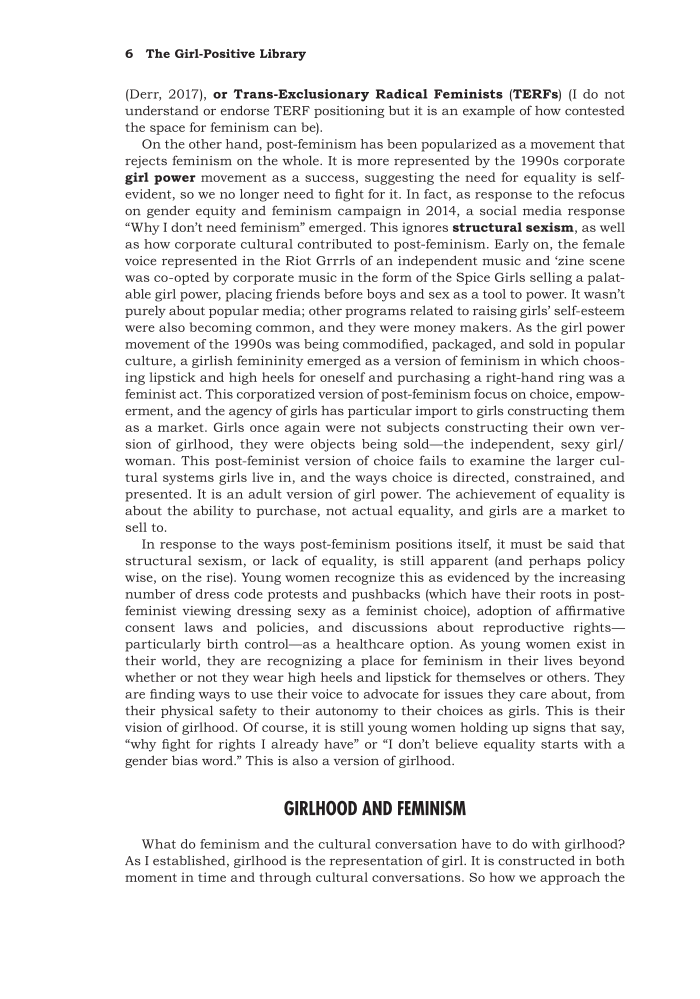6 The Girl-Positive Library (Derr, 2017), or Trans-Exclusionary Radical Feminists (TERFs) (I do not understand or endorse TERF positioning but it is an example of how contested the space for feminism can be). On the other hand, post-feminism has been pop u larized as a movement that rejects feminism on the whole. It is more represented by the 1990s corporate girl power movement as a success, suggesting the need for equality is self- evident, so we no longer need to fight for it. In fact, as response to the refocus on gender equity and feminism campaign in 2014, a social media response “Why I don’t need feminism” emerged. This ignores structural sexism, as well as how corporate cultural contributed to post-feminism. Early on, the female voice represented in the Riot Grrrls of an independent music and ‘zine scene was co-opted by corporate music in the form of the Spice Girls selling a palat- able girl power, placing friends before boys and sex as a tool to power. It wasn’t purely about popular media other programs related to raising girls’ self-esteem were also becoming common, and they were money makers. As the girl power movement of the 1990s was being commodified, packaged, and sold in popular culture, a girlish femininity emerged as a version of feminism in which choos- ing lipstick and high heels for oneself and purchasing a right-hand ring was a feminist act. This corporatized version of post-feminism focus on choice, empow- erment, and the agency of girls has partic u lar import to girls constructing them as a market. Girls once again were not subjects constructing their own ver- sion of girlhood, they were objects being sold—the independent, sexy girl/ woman. This post-feminist version of choice fails to examine the larger cul- tural systems girls live in, and the ways choice is directed, constrained, and presented. It is an adult version of girl power. The achievement of equality is about the ability to purchase, not actual equality, and girls are a market to sell to. In response to the ways post-feminism positions itself, it must be said that structural sexism, or lack of equality, is still apparent (and perhaps policy wise, on the rise). Young women recognize this as evidenced by the increasing number of dress code protests and pushbacks (which have their roots in post- feminist viewing dressing sexy as a feminist choice), adoption of affirmative consent laws and policies, and discussions about reproductive rights— particularly birth control—as a healthcare option. As young women exist in their world, they are recognizing a place for feminism in their lives beyond whether or not they wear high heels and lipstick for themselves or others. They are finding ways to use their voice to advocate for issues they care about, from their physical safety to their autonomy to their choices as girls. This is their vision of girlhood. Of course, it is still young women holding up signs that say, “why fight for rights I already have” or “I don’t believe equality starts with a gender bias word.” This is also a version of girlhood. GIRLHOOD AND FEMINISM What do feminism and the cultural conversation have to do with girlhood? As I established, girlhood is the represen ta tion of girl. It is constructed in both moment in time and through cultural conversations. So how we approach the
Document Details My Account Print multiple pages
Print
You have printed 0 times in the last 24 hours.
Your print count will reset on at .
You may print 0 more time(s) before then.
You may print a maximum of 0 pages at a time.













































































































































































